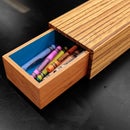Introduction: How to Make Machinable Wax at Home!
Featured on Hackaday.com! Woohoo! But for records sake, my name is Jake: http://hackaday.com/2012/12/29/make-your-own-machinable-wax
====================================================================================================
A major issue that I ran into when I first started working with my new CNC machine was the cost of raw materials to machine. Sure, a block of plastic is not terribly expensive by itself – but figure in the cost after you mess something up and the cost becomes quite unreasonable. For this reason, I began looking into machinable wax.
Machinable wax is a very hard wax that won’t gum up a cutting tool, is soft enough to machine quickly and most importantly is completely reusable! Since I am cheap, I decided to make my own, which is actually quite simple and could be considered environmentally friendly since we use recycled plastic bags. Be aware that this Instructable is DANGEROUS! We will be melting wax
around 300* and this wax will be thick and sticky so it will literally burn your skin off faster than you can say “OUCH!”
(The basic recipe is 4 parts wax to 1 part plastic)
You will need:
- Paraffin Wax (Available at Hobby Lobby)
- Plastic Shopping Bags (HDPE or LDPE, Recycle symbol #2 or #4)
- Deep fryer WITH adjustable thermostat
- Candy Thermometer (to make sure your fryer thermostat is working correctly)
- Wood Spoon
- Leather Gloves
- Safety Glasses
- Molds (I’ve used Tins, Wood frames, and Cardboard)
- Strainer
- Wax paper is handy
- A scale to measure wax/plastic
Step 1: Melting Wax
Set your deep fryer to the “Warm” setting or 100* if applicable and add the paraffin wax. Keep stirring the wax until it is completely liquid. Once melted, you could add a crayon for color if you would like. I recommend leaving the candy thermometer in the wax to keep a better eye on the temperature.
Paraffin ignites at around 400*F.
Don't forget that what your looking at is melted wax, not water. Hot water will splash and drip off of you, hot wax will splash and STICK TO YOUR SKIN! So be careful....
Step 2: Melting Bags
Set your deep fryer to 300*F and monitor the temperature with the thermometer. Make sure you continue to stir the wax because we do not want any hot spots that could cause the wax to ignite.
Once you hit 300*, begin adding the plastic bags, one at a time. It helps to cut them into strips so that they wont ball up, but I don’t have any data to support a specific way just yet. The more your stir this mixture, the faster the bags will dissolve (Just don't get too crazy, you could introduce a lot of air into the wax). Continue adding bags until they won’t dissolve any more. Most of the plastic should have dissolved, leaving just a few chunks left. With LDPE this is usually a 25% mixture, whereas HDPE bags are around 15%. Stay patient, this process can take a while.
Step 3: Casting the Wax
Once your bags are dissolved, it is almost time to pour the wax into molds. You may have some small clumps of plastic at this point, and there are a few different ways to remove them. The first option is to use a kitchen strainer to filter out the clumps as your pour the liquid goo into your molds. This works very well, but I have yet to be able to re-use the kitchen strainer afterwards. The second (and less effective) is to turn off your fryer and let the clumps float to the top. The top of the liquid will start to solidify and make it easier to skim off the clumps with a spoon. Either way, wear leather gloves!
If you chose option #2, turn your fryer back on and make sure your wax is liquid before pouring. When pouring into molds, pour slowly but be committed as you do not want wax to drip down the side of your fryer. Once poured, cover the molds with a towel so that they cool slowly. The slower they cool, the more likely that air bubbles will escape before getting stuck in the wax.
Step 4: Machine That Wax!
Out of the mold, the wax will have a HUGE sink mark in the middle; I usually just clamp the sides of the block and face off about ¼” to get it flat. Then I flip the block and machine to thickness. If you are carful and clean your vacuum ahead of time, you can save the chips to re-melt later. I keep a container nearby where I store my wax chips.
Recycle Your Wax
When recycling your wax, I recommend using no more than 50%-75% reground wax. This is due to the fact that plastics degrade rapidly when heated (think compost) and can start to smoke/burn/ignite if you are not careful. Therefore, start by melting paraffin wax, adding new bags and THEN adding your recycled wax.
Good luck and be safe!













